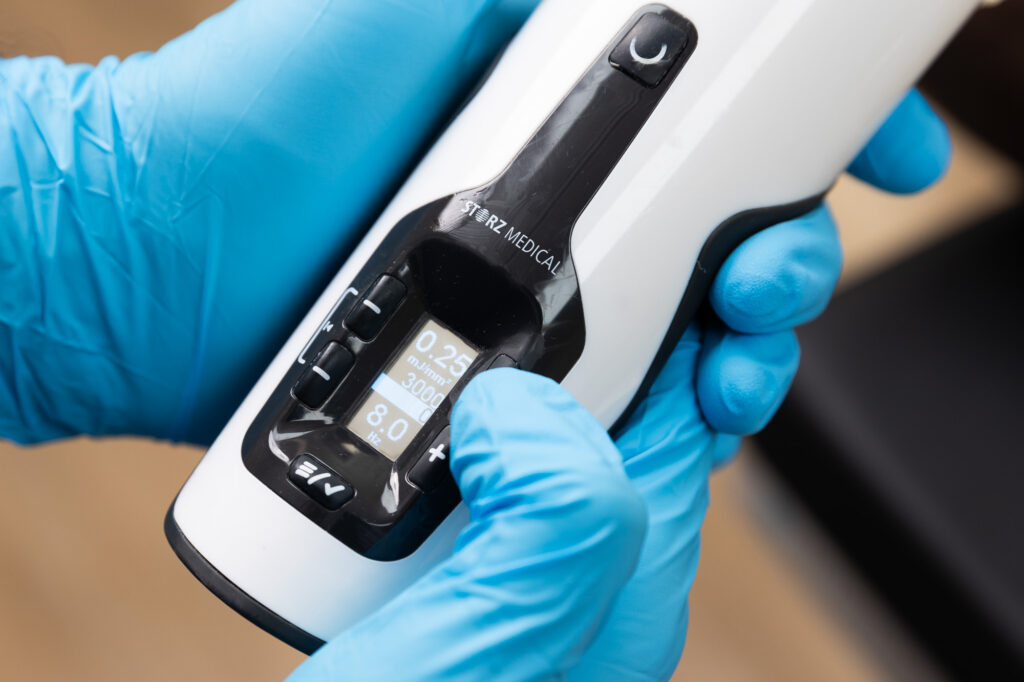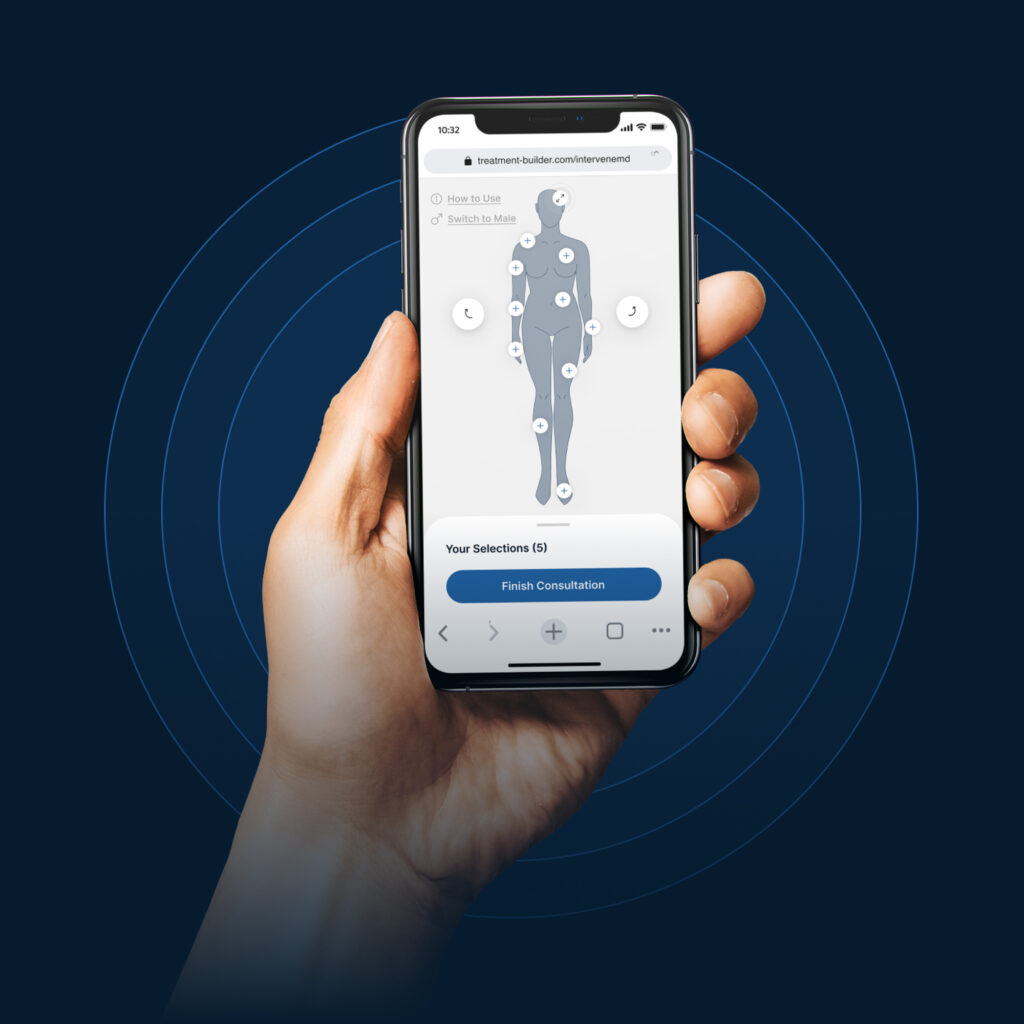
Shockwave and Magnet Therapies
Treatment Overview
Shockwave Therapy (ESWT)
We provide this information to help you. If you have a specific question and don’t see an answer here, please don’t hesitate to contact us. We welcome the opportunity to develop your personalized treatment plan to get you back in action!
Seeing us for the first time? Please complete our New Patient Pre-Visit Questionnaire and bring it to your first appointment.
Schedule your Shockwave Consultation
Shockwave therapy is a non-invasive, non-injection therapy that delivers strong energy pulses to the affected area.
This stimulates the cells in the body responsible for bone and connective tissue healing. It is gentle on tissue and can help alleviate pain long-term.
A gel is applied to the treatment area to allow the shockwaves to be passed into the body without any loss of energy. After this preparation, a wand is moved over the pain region in a circular motion, passing the energy impulses to the tissue.
Each therapy session takes between 5-10 minutes, depending on the disorder treated. For acute injuries, an average of 6-8 treatments are necessary at weekly intervals.
Shockwave Therapy (ESWT)
Commonly Treated Conditions
Epicondylitis (Tennis or Golfer’s elbow)
Tennis elbow is known as lateral epicondylitis, and occurs when the forearm tendons are weakened and inflamed due to repetitive activities. Tennis players are particularly susceptible to this as they are constantly rotating their arm to apply spin to the ball while firmly gripping the racket. Golfer’s elbow, involves similar symptoms, but on the inside of the elbow.
Patellar tendinitis (Jumper’s Knee)
The patellar tendon attaches the kneecap (patella) to the shinbone. During high stress activities like running, jumping and kicking, this tendon can develop tiny tears that can have trouble healing. This is frequently called Jumper’s knee because it typically involves jumping sports such as basketball.
Tibial Stress Syndrome (Shin Splint)
Tibial stress syndrome, also known as “shin splints”, is a painful sensation in the shins due to overused muscles, tendon and bone tissue. Shin splints most commonly occur in sports with quick direction changes, but also in untrained athletes, e.g. after weight gain or after a change of footwear.
Arthritis of the big toe
Shockwave can improve this condition which makes walking or standing very uncomfortable.
Scar tissue
Shockwave can help break down scar tissue, which is a collection of cells and collagen, that the body uses in the repair process. Additionally shock wave increases blood circulation to help these areas heal.
Bone fracture, non-unions
Non-unions are bone fractures that have failed to heal. By stimulating osteoblasts (the cells responsible for bone healing) shock wave therapy has been proven to be as effective as surgical procedures but free of side effects and much less expensive.
Stress fractures
Stress fractures are small cracks that usually occur in the weight-bearing bones of the spine, foot and leg. People who have osteoporosis, or weakened bone, are particularly susceptible to this condition. Research has shown shock wave to be over 90% successful in treating stress fractures.
Frozen shoulder
Frozen shoulder, otherwise known as adhesive capsulitis, causes pain and stiffness in the shoulder joint. It is most common in females, aged 40-60 and can take up to 2 years to heal. Shock wave can significantly shorten this healing time.
Tendinopathy
Tendons are the tapered part of a muscle as it tapers down to attach to a bone. They can frequently get overstretched and injured, leading to inflammation and chronic dysfunction. These injuries occur most often in and around the foot, heel, knee, hip, elbow and shoulder.
Trigger Points
Trigger points develop in muscles that are stressed or injured. Sometimes a knot (called a taut band) can be felt, causing the muscle to jump when pressed. Trigger points are sensitive to pressure and can cause pain to refer to other parts of the body.
Hamstring Tendinopathy
Hamstring injuries typically occur in sport activities that require sprinting. These muscles attach to the “sits bone” and can range from a mild “pulled muscle” or strain to a partial or complete tear.
Achillodynia (Chronic pain syndrome of Achilles tendon)
Achilles tendinopathy is an injury to the Achilles tendon that connects the calf muscles to the back of the heel bone. It is often seen in running sports and causes pain in the back of the calf or just above the heel bone.
Plantar Fasciitis (heel spur)
Plantar fasciitis is a common cause of heel pain caused by inflammation of the tough, thick band of tissue that connects the heel to the other bones in your foot along the arch. This tissue, called fascia, allows your foot to absorb the mechanical stress of walking. About half of all patients with plantar fasciitis develop heel bone spurs, and 75% of these cases respond to Shockwave.
Calcific Tendonitis of the shoulder
In this condition, calcium deposits on the rotator cuff tendons cause swelling and irritation, limiting movement of the shoulder and resulting in pain in the neck, shoulder and arm. This most frequently involves the supraspinatus tendon.
Bursitis
Bursa are fluid-filled sacs strategically placed throughout the body to provide cushioning and ease friction between muscles, bones, tendons and the skin. These sacs are primarily located around major joints including the knees, hips, elbows and shoulders. The most frequently diagnosed bursitis is over the side of the hip, or trochanter, where powerful gluteal muscles attach, including Lumbago (lower back pain), Trigger finger, Morton’s neuroma, Avascular necrosis of the hip, and Carpal tunnel syndrome.
Previous
Next
Epicondylitis (Tennis or Golfer’s elbow)
Tennis elbow is known as lateral epicondylitis, and occurs when the forearm tendons are weakened and inflamed due to repetitive activities. Tennis players are particularly susceptible to this as they are constantly rotating their arm to apply spin to the ball while firmly gripping the racket.
Golfer’s elbow, involves similar symptoms, but on the inside of the elbow.
Patellar tendinitis (Jumper’s Knee)
The patellar tendon attaches the kneecap (patella) to the shinbone. During high stress activities like running, jumping and kicking, this tendon can develop tiny tears that can have trouble healing. This is frequently called Jumper’s knee because it typically involves jumping sports such as basketball.
Tibial Stress Syndrome (Shin Splint)
Tibial stress syndrome, also known as “shin splints”, is a painful sensation in the shins due to overused muscles, tendon and bone tissue. Shin splints most commonly occur in sports with quick direction changes, but also in untrained athletes, e.g. after weight gain or after a change of footwear.
Arthritis of the big toe
Shock wave can improve this condition which makes walking or standing very uncomfortable.
Scar tissue
Shockwave can help break down scar tissue, which is a collection of cells and collagen, that the body uses in the repair process. Additionally shock wave increases blood circulation to help these areas heal.
Bone fracture, non-unions
Non-unions are bone fractures that have failed to heal. By stimulating osteoblasts (the cells responsible for bone healing) shock wave therapy has been proven to be as effective as surgical procedures but free of side effects and much less expensive. Source
Stress fractures
Stress fractures are small cracks that usually occur in the weight-bearing bones of the spine, foot and leg. People who have osteoporosis, or weakened bone, are particularly susceptible to this condition. Research has shown shock wave to be over 90% successful in treating stress fractures. Source
Frozen Shoulder
Frozen shoulder, otherwise known as adhesive capsulitis, causes pain and stiffness in the shoulder joint. It is most common in females, aged 40-60 and can take up to 2 years to heal. Shock wave can significantly shorten this healing time. Source
Tendinopathy
Tendons are the tapered part of a muscle as it tapers down to attach to a bone. They can frequently get overstretched and injured, leading to inflammation and chronic dysfunction. These injuries occur most often in and around the foot, heel, knee, hip, elbow and shoulder.
Trigger Points
Trigger points develop in muscles that are stressed or injured. Sometimes a knot (called a taut band) can be felt, causing the muscle to jump when pressed. Trigger points are sensitive to pressure and can cause pain to refer to other parts of the body.
Hamstring Tendinopathy
Hamstring injuries typically occur in sport activities that require sprinting. These muscles attach to the “sits bone” and can range from a mild “pulled muscle” or strain to a partial or complete tear.
Achillodynia (Chronic pain syndrome of Achilles tendon)
Achilles tendinopathy is an injury to the Achilles tendon that connects the calf muscles to the back of the heel bone. It is often seen in running sports and causes pain in the back of the calf or just above the heel bone.
Plantar Fasciitis (heel spur)
Plantar fasciitis is a common cause of heel pain caused by inflammation of the tough, thick band of tissue that connects the heel to the other bones in your foot along the arch. This tissue, called fascia, allows your foot to absorb the mechanical stress of walking. About half of all patients with plantar fasciitis develop heel bone spurs, and 75% of these cases respond to shock wave.
Calcific Tendonitis of the shoulder
In this condition, calcium deposits on the rotator cuff tendons cause swelling and irritation, limiting movement of the shoulder and resulting in pain in the neck, shoulder and arm. This most frequently involves the supraspinatus tendon.
Bursitis
Bursa are fluid-filled sacs strategically placed throughout the body to provide cushioning and ease friction between muscles, bones, tendons and the skin. These sacs are primarily located around major joints including the knees, hips, elbows and shoulders. The most frequently diagnosed bursitis is over the side of the hip, or trochanter, where powerful gluteal muscles attach, including Lumbago (lower back pain), Trigger finger, Morton’s neuroma, Avascular necrosis of the hip, and Carpal tunnel syndrome.
Magnet therapy is a new FDA-approved non-invasive procedure developed to treat musculoskeletal pain.
It differs from other forms of magnetic field therapy, such as pulsed electromagnetic field therapy (PEMF) as it produces a higher oscillation frequency and stronger magnetic field, also known as “transduction power”. It was developed in Europe and has been approved for use in the U.S. by the FDA.
EMTT is largely a risk-free, side-effect free and pain-free treatment that penetrates deep into the painful area, initiating an anti-inflammatory response and reducing pain. Direct skin contact is not necessary so patients can remain fully clothed.
High energy magnetic pulses are then transmitted to your body in a session that lasts about 5-10 minutes, for about 6-8 sessions, depending on the diagnosis.
Treatment Overview
Extracorporeal Magnetotransduction Therapy (EMTT)

Schedule your Magnet Therapy Consultation
Magnet Therapy (EMTT)
Commonly Treated Conditions
Sports injuries to tendons and joints
Tendon overuse injuries
Inflammation over the pubic bone
Back & Lower back
Tension Nerve root pain
Osteoarthritis
Herniated discs
Spondyloarthritis of the spine
Bone fractures



